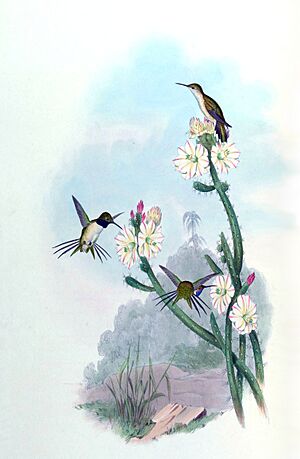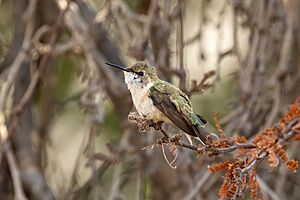Chilean woodstar facts for kids
Quick facts for kids Chilean woodstar |
|
|---|---|
 |
|
| Conservation status | |
| Scientific classification | |
| Genus: |
Eulidia
|
| Species: |
yarrellii
|
| Synonyms | |
|
Myrtis yarrellii |
|
The Chilean woodstar (Eulidia yarrellii) is a tiny hummingbird found only in Chile. It is one of the smallest birds in the world. This special bird is currently listed as Critically Endangered, which means it's at a very high risk of disappearing forever. It's the only species in its group, called Eulidia. The bird's name honors an English nature expert named William Yarrell.
Contents
About the Chilean Woodstar
A Unique Hummingbird Species
The Chilean woodstar is a very special type of hummingbird. It's the only species in its own group, or genus, called Eulidia. This means it's quite unique among hummingbirds.
What Does the Chilean Woodstar Look Like?
The Chilean woodstar is a small bird. It is about 7.5 to 8.0 centimeters (3 inches) long. It weighs only about 2.3 to 2.6 grams, which is less than a penny! It is the smallest bird in Chile. Both male and female woodstars have a short, black beak.
The male woodstar is quite colorful. Its back is a shiny olive green. Its belly is white. The throat, called a gorget, is a mix of reddish-purple and blue. This can sometimes look black. Its tail feathers are interesting. The middle ones are short and green. The outer ones are longer, blackish-brown, and curve inwards.
Female woodstars are also olive green on their backs. But their undersides are mostly a pale, creamy color. This color is darkest on their belly and legs. Their tail is short and has green middle feathers. The outer feathers are black with white tips. Young males look a lot like females. They might have a spotted throat and longer outer tail feathers.
How to Tell it Apart from Similar Birds
There's another bird, the Peruvian sheartail, that looks very similar. It also lives in the same areas as the Chilean woodstar. However, there are a few ways to tell them apart. Male sheartails have two long, white feathers in their tail. Female sheartails usually have a whiter belly and a creamier throat than the woodstar. The Chilean woodstar often flies with its tail pointing up. It also doesn't usually pump its tail up and down like the sheartail does.
Where the Chilean Woodstar Lives
Home in Northern Chile
The Chilean woodstar is currently found only in a small part of northern Chile. It lives in the Lluta, Azapa, and Vitor valleys. These valleys are in the Arica and Parinacota Region. There are old records of it living further south. Some people have also reported seeing it in southern Peru. However, these sightings are not officially confirmed.
Preferred Habitats and Elevation
This hummingbird likes to live in scrublands, thick bushes, and gardens. These areas are usually found along river valleys in the dry Arica region. It usually lives at elevations between 200 and 750 meters (about 650 to 2,460 feet) above sea level. It is most common below 400 meters (1,300 feet). There is a small group of them living higher up, around 1,800 meters (5,900 feet). Some single sightings have even been as high as 3,000 meters (9,800 feet).
Chilean Woodstar Behavior
Movement and Migration
Scientists believe the Chilean woodstar mostly stays in one place. It doesn't travel far. However, the sightings at high elevations suggest they might move up and down mountains. This movement might depend on having continuous plants along the river valleys.
What the Chilean Woodstar Eats
The Chilean woodstar mainly eats nectar from flowers. It gets nectar from many different types of plants. These include native flowers, shrubs, cacti, and trees. Some native plants it likes are Inga feulles and Schinus molle. It also feeds on introduced plants like Lantana, Hibiscus, and Citrus species.
It usually looks for food alone. But in the past, many woodstars were seen feeding together on flowering trees. Besides nectar, the woodstar also eats small insects. It catches these insects while flying. These insects include tiny wasps, aphids, and beetles.
Breeding and Nests
Chilean woodstars have been seen nesting in May, August, and September. This suggests they might nest twice a year. They might even nest at any time of the year. Most nests found have been in olive trees. These nests are usually about 2.3 meters (7.5 feet) above the ground. Some nests have also been found in native shrubs and garden trees. Not much else is known about how they raise their young.
Sounds and Calls
The Chilean woodstar makes a rasping "tsick" sound. This call is quieter and "less musical" than the call of the Peruvian sheartail. Male woodstars also have a special display call. It's a high-pitched, buzzing "zrrrrrrr" sound.
Protecting the Chilean Woodstar
Conservation Status
The Chilean woodstar is in serious trouble. In 1988, it was first listed as Threatened. Over the years, its situation got worse. In 2014, it was declared Critically Endangered. This is the highest risk category before extinction.
Its living area is very small. It covers about 6,220 square kilometers (2,400 square miles). There are only about 210 adult birds left. In total, there are around 300 individuals. In the early 1900s, this bird was very common. Even in the 1980s, over 100 could be seen feeding in one tree. Since then, its numbers have dropped a lot. In 2003, there were about 1,500 birds. By 2012, there were only about 500.
Threats to Survival
The biggest threat to the Chilean woodstar is the loss of its home. Many natural areas where it lives have been turned into farms. This leaves only small patches of suitable plants.
Other possible threats include pesticides. These chemicals used in farming might harm the birds. Competition with the Peruvian sheartail is another concern. The sheartail is much more numerous. There's also a worry about the woodstar breeding with the sheartail. This could make the woodstar's unique genes disappear.
Conservation Efforts
A plan to help the Chilean woodstar was approved in 2004. This plan includes several important steps. It aims to keep track of the bird's population. It also plans to restore the natural plants it needs. Scientists are also studying how it competes with the Peruvian sheartail. There's even a possibility of bringing the birds back to areas where they used to live.



